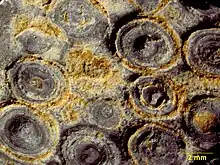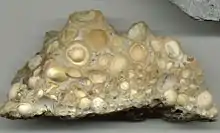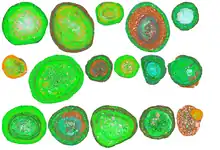Pisolite
A pisolite (from Ancient Greek πίσον (píson) 'pea') is a sedimentary rock made of pisoids, which are concretionary grains – typically of calcium carbonate which resemble ooids, but are more than 2 mm in diameter.[1] These grains are approximately spherical and have concentric layers reaching 10 mm in diameter.

Pisoids in the Conococheague limestone (Upper Cambrian) of eastern Pennsylvania

Pisolitic limestone; Itaboraí, Rio de Janeiro, Brazil; pisolith diameters average 1.0 cm

QEMSCAN mineral map of pisoids
Bauxites, limonites, and siderites often have a pisolitic structure.
References
Further reading
- Manutchehr-Danai, Mohsen (2009). Dictionary of gems and gemology (3rd ed.). Springer. ISBN 978-3-540-72795-8.
This article is issued from Wikipedia. The text is licensed under Creative Commons - Attribution - Sharealike. Additional terms may apply for the media files.